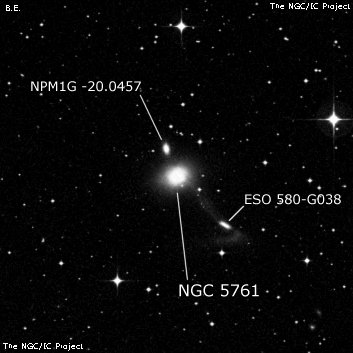
Francis Leavenworth discovered NGC 5761 = LM 1-211 in 1886 and recorded "mag 14.5, 0.3' dia, R, glbMN." His rough position (nearest min of RA) is 6' north of ESO 580-039 and also 36 sec of RA west of ESO 580-040. The galaxy directly south of his position is brighter, but Leavenworth's positions are more often off in RA, suggesting ESO 580-040 is the correct identification.
RNGC, ESO-LV and RC3 identify ESO 580-039 as NGC 5761. But in the South Equatorial Galaxy Catalogue (ESGC) and an early NGC errata list, Harold Corwin identified ESO 580-040 as NGC 5761. Without a discovery sketch, either identification is plausible. See Corwin's identification notes.
400/500mm - 17.5" fairly faint, fairly small, round, 1' diameter. The faint outer halo rises sharply to a 15" bright core. Brightest in a small group with ESO 580-040 12' NE. The NGC identification is uncertain and NGC 5761 may be ESO 580-040. This is a disrupted interacting galaxy with a long connecting tail SW to a faint companion. PGC 52918 close north was not seen with certainty in breezy conditions.
900/1200mm - 48" (5/12/12): at 488x appeared bright, fairly large, oval 5:4 ~E-W, ~1.2'x0.9', sharply concentrated with a very bright, oval core, halo fades out gradually. A mag 16 star lies 45" SW. Two companions are on opposite sides of the galaxy: PGC 52918 is 50" NNE of center and ESO 580-038 lies 1.9' SW. The PGC appeared fairly faint, small, slightly elongated ~N-S, 15"x12", brighter core. The ESO was fairly faint, fairly small, very elongated 3:1 SW-NE, ~21"x7". The tidal plume connecting NGC 5761 to the ESO by a long tidal plume was not convincingly seen (though by Lowrey).
Notes by Steve Gottlieb